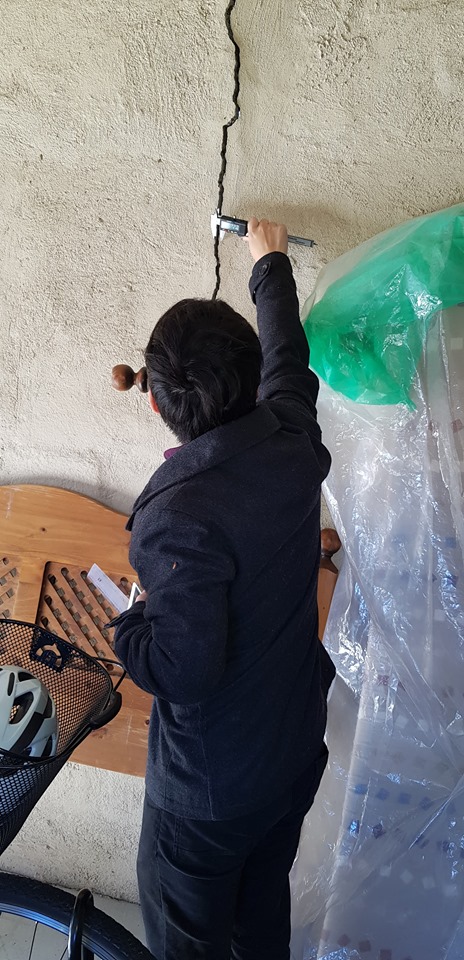 Have you noticed cracks in your house? Once you see them, you can’t NOT focus on them. But before you have dreams of your walls collapsing, you’re going to want to read this article.
Have you noticed cracks in your house? Once you see them, you can’t NOT focus on them. But before you have dreams of your walls collapsing, you’re going to want to read this article.
Take a deep breath, inform yourself, and know that there’s help available. Don’t be afraid to inspect the cracks, so you can explain the damage with a structural engineer. This isn’t the type of DIY work you want to tackle yourself.
Experienced engineers diagnose and fix cracks in buildings… and give you insights into how resilient (or weak) the structure is.
If you think the building is unstable, contact a residential structural engineer immediately. Keep the area clear and wait for a technician to design and document a permanent solution.
But more often, house cracks won’t require immediate attention.
Make Diary Records.
We suggest keeping a Crack Diary to monitor the damage.
Your diary can log where the cracks are, how long they’ve been there, their dimensions, and any other specific characteristics. Write a new entry every two or four weeks. Your notes can be as simple as ‘no change’, ‘some change’ or detailing the change you see.
Take Photos.
To compliment your written records, keep a visual ‘diary’ by taking photos. Take close-up shots of the damage and use any tools available to track the progress of the cracks, like a tape measure.
Level Checking Tools.
There are tools available to householders that tell you if your slab is level. However, most are too complicated for the homeowner, which is why we suggest floor level and integrity, using a simple digital inclinometer.
Instead of delving into tricky systems that require an expert eye (and time to explore the damage and results), ask for help from a structural engineer in Adelaide.
Renovating or extending? Selling your house?
Attending to the house cracks is a must, BEFORE you do anything. You might be covered by the builder’s insurance policy, depending on how old your house is. The age is important to keep in mind. Why? Because a 15-year-old house and a 15-year-old crack that hasn’t changed in a decade is different than a house built three years ago, with a new, fast-growing crack.
And, what are the common causes of cracking?
Slab heave occurs when there are changes in soil and moisture conditions. Often attributed as diagonal cracks starting at doors and windows, gaps under internal walls, and broken cornices.
Consolidation of soft soils is also another leading cause. There’s a downward movement of the house slab and footings, within the first two years of construction. Soft or loose soil becomes vulnerable under the weight of the house. Poorly compacted backfill over council sewer pipes and underground infrastructure also impacts the soil’s integrity.
Slope failure happens when a building is too close to a slope without ample footing protection or depth, leading to instability.
And finally, poor workmanship. While not as common a fault, it happens. When the plasterboard hasn’t been properly nailed or back-blocked, straight cracks in ceilings or walls start to emerge.
There are a few other details to consider when isolating the cause of the crack:
- What sort of house is it? Single or double storey? Brick veneer or concrete brick? Roof tiles or metal sheet? These are all clues, as to what might be causing the damage.
- Has something changed recently? Have you recently experienced flooding? Planted new trees? Added anything new to your house? Again, we’re looking for clues.
- Did the damage occur as a result of an insurable scenario? This is a good time to start a conversation with your insurance company.
House damage can be caused by a wide range of changes… soil moisture conditions, downward movement of the house slab and poor workmanship, for example.
We suggest contacting a licensed plumber to check the integrity of your sewer, stormwater, and supply pipes. Leaks in pipes cause extensive damage. Engage with a local technician with access to a drain camera for quick answers. You want to rule out ‘invisible’ breaks. Your plumber should also conduct hydrostatic testing – checking to see if the water level drops. All damage should be attended to immediately.
Fixing the cracks in your house.
First, we find the cause of the damage. This is where a structural engineer steps in, to make sure it doesn’t happen again. Then, those findings go to the repairer, who fixes the cracks.
Feel free to send us your photos of the cracks for preliminary advice, pre-inspection. Book your consultation with our head Structural Engineer, Naveesh Sharma. Fill in your details in the contact form and we’ll get back to you. In the meantime, start your House Crack Diary.#
